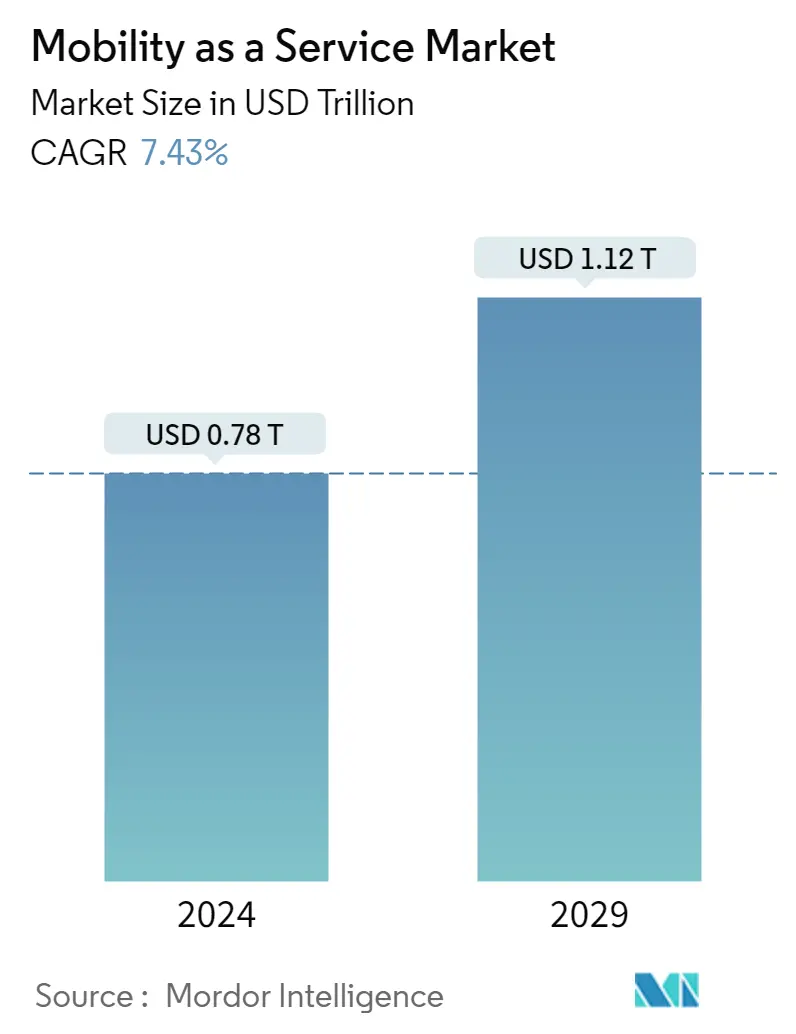Market Size of Mobility as a Service Industry

| Study Period | 2019 - 2029 |
| Market Size (2024) | USD 0.78 Trillion |
| Market Size (2029) | USD 1.12 Trillion |
| CAGR (2024 - 2029) | 7.43 % |
| Fastest Growing Market | Asia-Pacific |
| Largest Market | North America |
| Market Concentration | Low |
Major Players
*Disclaimer: Major Players sorted in no particular order |
Mobility as a Service (MaaS) Market Analysis
The Mobility as a Service Market size is estimated at USD 0.78 trillion in 2024, and is expected to reach USD 1.12 trillion by 2029, growing at a CAGR of 7.43% during the forecast period (2024-2029).
The COVID-19 pandemic hurt mobility as a Service Market. With the lockdown and social distancing norms implemented worldwide, the need for mobility was reduced except for emergency purposes. With almost zero public movements, the major business area of the market was severely hit, and the economy took a nosedive. Although the COVID-19 pandemic has caused problems for the market, it has also given rise to chances for innovation and adaptation, such as the deployment of MaaS solutions for contactless payments and contact tracking.
Over the medium term, Mobility as a Service (MaaS) is a growing industry that intends to provide individuals and businesses with integrated, on-demand transportation solutions. It represents a paradigm shift from traditional modes of transportation, in which consumers can access a variety of mobility alternatives through a single platform, frequently via a subscription-based approach. The market is predicted to expand rapidly in the next years, owing to rising urbanization, increased traffic congestion, and a need for more sustainable transportation alternatives.
Passengers' preferences for utilizing taxi services and ride-sharing services across the country are expected to increase. Hence, this is likely to lead the companies to enhance the options and expand their operations to be provided in mobile applications, to retain their respective market shares in a highly competitive market.
The growing emphasis on lowering carbon emissions and mitigating climate change is one of the primary drivers of the MaaS sector. MaaS platforms may help lessen the environmental effect of transportation by providing more sustainable mobility options.
Another important aspect driving the market is changing consumer tastes, particularly among younger generations that prioritize convenience, flexibility, and cost-effectiveness in their mobility options.
Other players, such as automakers and public transportation agencies, are entering the MaaS sector to stay competitive and meet evolving customer expectations, in addition to traditional transportation corporations and tech startups.
Government initiatives and legislation, such as subsidies for electric vehicles and encouragement for carpooling and public transit use, are also shaping the MaaS market. Mobile apps, Internet of Things (IoT) gadgets, and data analytics tools are a few of the primary technologies powering the MaaS sector. These technologies enable more effective and individualized transportation services.
Mobility as a Service (MaaS) Industry Segmentation
Mobility as a service integrates various forms of transportation services. It allows a variety of transportation services access, including public transport, ride-share, and rental.
The Mobility as a Service Market is Segmented by Service Type (Car, Bus, and Bike), Transportation Type (Public and Private), and Geography (North America, Europe, Asia-Pacific, and the Rest of the World). The report offers market size and forecasts for Mobility as a Service in terms of value (USD billion) for all the above segments.
| By Service Type | |
| Car | |
| Bus | |
| Bike |
| By Transportation Type | |
| Public | |
| Private |
| By Geography | |||||||
| |||||||
| |||||||
| |||||||
|
Mobility as a Service Market Size Summary
The Mobility as a Service (MaaS) market is experiencing a transformative phase, driven by the need for integrated, on-demand transportation solutions that cater to both individuals and businesses. This sector represents a significant shift from traditional transportation methods, offering consumers access to various mobility options through a single platform, often on a subscription basis. The market's growth is fueled by increasing urbanization, traffic congestion, and the demand for sustainable transportation alternatives. The emphasis on reducing carbon emissions and combating climate change is a key driver, as MaaS platforms promote environmentally friendly mobility choices. Additionally, changing consumer preferences, particularly among younger generations who value convenience and cost-effectiveness, are shaping the market dynamics. The entry of diverse players, including automakers and public transportation agencies, alongside traditional transportation companies and tech startups, is further intensifying competition and innovation within the sector.
The MaaS market is poised for substantial expansion, with cities worldwide adopting these solutions to address transportation challenges and enhance accessibility. Technological advancements, such as mobile apps, IoT devices, and data analytics, are central to the sector's evolution, enabling more efficient and personalized transportation services. Government initiatives, including subsidies for electric vehicles and incentives for public transit use, are also influencing market growth. The fragmented nature of the market sees significant contributions from prominent companies like Uber, Didi, and Moovit, which are investing in research and development to innovate and expand their offerings. The market's trajectory is supported by strategic collaborations and pilot projects in various regions, including China and India, where MaaS is gaining traction as a viable solution to urban mobility challenges. As the market continues to evolve, it is expected to play an increasingly critical role in shaping the future of transportation, offering new business models and opportunities for both public and private sector stakeholders.
Mobility as a Service Market Size - Table of Contents
-
1. MARKET DYNAMICS
-
1.1 Market Drivers
-
1.2 Market Restraints
-
1.3 Industry Attractiveness - Porter's Five Forces Analysis
-
1.3.1 Bargaining Power of Buyers/Consumers
-
1.3.2 Bargaining Power of Suppliers
-
1.3.3 Threat of New Entrants
-
1.3.4 Threat of Substitute Products
-
1.3.5 Intensity of Competitive Rivalry
-
-
-
2. MARKET SEGMENTATION (Market Size in Value - (USD Billion)
-
2.1 By Service Type
-
2.1.1 Car
-
2.1.2 Bus
-
2.1.3 Bike
-
-
2.2 By Transportation Type
-
2.2.1 Public
-
2.2.2 Private
-
-
2.3 By Geography
-
2.3.1 North America
-
2.3.1.1 United States
-
2.3.1.2 Canada
-
2.3.1.3 Rest of North America
-
-
2.3.2 Europe
-
2.3.2.1 Germany
-
2.3.2.2 United Kingdom
-
2.3.2.3 France
-
2.3.2.4 Rest of Europe
-
-
2.3.3 Asia-Pacific
-
2.3.3.1 India
-
2.3.3.2 China
-
2.3.3.3 Japan
-
2.3.3.4 South Korea
-
2.3.3.5 Rest of Asia-Pacific
-
-
2.3.4 Rest of the World
-
2.3.4.1 South America
-
2.3.4.2 Middle-East and Africa
-
-
-
Mobility as a Service Market Size FAQs
How big is the Mobility as a Service Market?
The Mobility as a Service Market size is expected to reach USD 0.78 trillion in 2024 and grow at a CAGR of 7.43% to reach USD 1.12 trillion by 2029.
What is the current Mobility as a Service Market size?
In 2024, the Mobility as a Service Market size is expected to reach USD 0.78 trillion.

